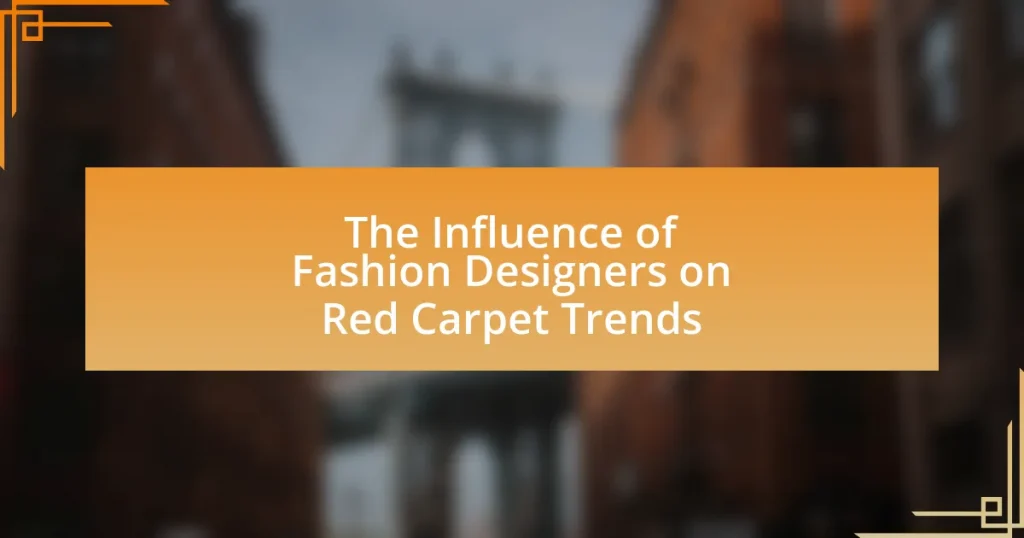The article examines the significant influence of fashion designers on red carpet trends, highlighting how designers like Versace, Valentino, and Dior set aesthetic standards that shape public perception of style. It discusses the cyclical relationship between designers and celebrities, emphasizing how exclusive collections debuted at major events lead to trends that consumers seek to emulate. Key elements of this influence include creativity, brand identity, and cultural relevance, as well as the impact of celebrity endorsements and social movements on fashion choices. The article also addresses the challenges designers face in balancing creativity with commercial viability and the importance of social media in shaping trends.

What is the Influence of Fashion Designers on Red Carpet Trends?
Fashion designers significantly influence red carpet trends by setting aesthetic standards and creating iconic looks that shape public perception of style. Designers like Versace, Valentino, and Dior often debut exclusive collections during major events, which celebrities then wear, thereby establishing trends that are widely emulated. For instance, the 2019 Met Gala showcased numerous designs by high-profile designers, leading to a surge in popularity for bold colors and intricate embellishments in subsequent red carpet appearances. This cyclical relationship between designers and celebrities not only drives fashion trends but also impacts consumer behavior, as fans seek to replicate the styles seen on the red carpet.
How do fashion designers shape red carpet aesthetics?
Fashion designers shape red carpet aesthetics by creating unique, high-impact garments that set trends and define the visual narrative of events. Their designs often reflect cultural moments, celebrity identities, and artistic expressions, influencing public perception and media coverage. For instance, designers like Versace and Valentino have historically crafted iconic looks that not only enhance the wearer’s image but also resonate with broader fashion movements, as seen when Jennifer Lopez wore the famous green Versace dress at the 2000 Grammy Awards, which sparked a global trend for bold prints and plunging necklines. This interplay between designer creativity and celebrity influence establishes a dynamic that continually evolves red carpet fashion.
What are the key elements of a designer’s influence on red carpet fashion?
The key elements of a designer’s influence on red carpet fashion include creativity, brand identity, and cultural relevance. Designers showcase their unique vision through innovative designs that often set trends, as seen with iconic figures like Alexander McQueen and his theatrical presentations that transformed red carpet aesthetics. Brand identity plays a crucial role, as established designers like Versace or Dior create signature styles that celebrities often gravitate towards, reinforcing their brand’s presence in popular culture. Additionally, cultural relevance is significant; designers often draw inspiration from current events, social movements, or historical references, which can resonate with the audience and elevate the overall impact of red carpet appearances. For instance, the rise of sustainable fashion has led designers like Stella McCartney to influence red carpet choices with eco-friendly materials, reflecting a growing awareness of environmental issues.
How do designers’ backgrounds affect their red carpet designs?
Designers’ backgrounds significantly influence their red carpet designs by shaping their aesthetic sensibilities, cultural references, and technical skills. For instance, a designer trained in haute couture may prioritize intricate detailing and luxurious fabrics, while a designer from a streetwear background might focus on bold graphics and casual silhouettes. This diversity in training and experience leads to a wide range of styles on the red carpet, reflecting the designers’ unique perspectives. Historical examples include the impact of Alexander McQueen’s British heritage and theatrical training, which resulted in dramatic and avant-garde designs, contrasting with the minimalist approach of Calvin Klein, who emphasized American simplicity and functionality. Such backgrounds not only inform the visual language of their creations but also resonate with the cultural narratives they wish to convey through their work.
Why is the red carpet significant in the fashion industry?
The red carpet is significant in the fashion industry because it serves as a high-profile platform for designers to showcase their creations to a global audience. This visibility allows designers to influence fashion trends and establish their brand identity, as celebrities often wear exclusive designs during major events like the Oscars and Met Gala. For instance, the 2021 Oscars featured numerous gowns by renowned designers, which subsequently set trends for the upcoming fashion seasons. The red carpet not only highlights individual creativity but also drives consumer interest and sales in the fashion market, making it a crucial element of the industry’s ecosystem.
What role does celebrity endorsement play in red carpet trends?
Celebrity endorsement significantly shapes red carpet trends by influencing public perception and fashion choices. When high-profile celebrities wear specific designers or styles, it creates a ripple effect, leading to increased visibility and desirability of those fashion choices among the general public. For instance, when celebrities like Lupita Nyong’o or Rihanna don outfits from particular designers, it often results in a surge in demand for those designers’ collections, as evidenced by the immediate increase in online searches and sales following red carpet appearances. This phenomenon illustrates how celebrity endorsements not only highlight individual fashion statements but also drive broader trends within the fashion industry.
How do red carpet events impact public perception of fashion designers?
Red carpet events significantly enhance public perception of fashion designers by showcasing their creations to a global audience. These high-profile occasions provide designers with a platform to display their work, often leading to increased visibility and brand recognition. For instance, when celebrities wear a designer’s outfit on the red carpet, it can result in a surge of interest and sales for that designer, as seen with brands like Versace and Gucci during major award shows. This visibility not only elevates the designer’s status but also influences fashion trends, as the public often seeks to emulate the styles seen on their favorite stars.

What are the current trends in red carpet fashion influenced by designers?
Current trends in red carpet fashion are characterized by bold colors, sustainable materials, and innovative silhouettes, heavily influenced by leading designers. Designers like Valentino and Gucci are embracing vibrant hues and intricate embellishments, while others, such as Stella McCartney, focus on eco-friendly fabrics and ethical production methods. Additionally, the rise of gender-fluid fashion is evident, with designers like Harris Reed challenging traditional gender norms through their creations. These trends reflect a shift towards individuality and sustainability in high-profile fashion events, showcasing how designers are shaping the future of red carpet style.
Which designers are currently leading red carpet trends?
Currently, designers such as Valentino, Versace, and Schiaparelli are leading red carpet trends. Valentino has gained attention for its bold colors and dramatic silhouettes, while Versace continues to dominate with its signature glamour and daring cuts. Schiaparelli is recognized for its avant-garde designs that blend art and fashion, making a significant impact on high-profile events. These designers have consistently dressed celebrities at major award shows, influencing the overall aesthetic and direction of red carpet fashion.
What signature styles are associated with these leading designers?
Leading designers are associated with distinct signature styles that significantly influence red carpet trends. For example, Alexander McQueen is known for his dramatic silhouettes and avant-garde designs, often incorporating elements of gothic and romantic aesthetics. Chanel, under the legacy of Coco Chanel, is recognized for its timeless elegance, characterized by tailored suits and the iconic little black dress. Versace is synonymous with bold prints and vibrant colors, often featuring daring cuts that emphasize the body. Valentino is celebrated for its romantic and feminine designs, particularly the use of luxurious fabrics and intricate embellishments. These signature styles not only define the designers but also shape the fashion choices of celebrities on the red carpet, reflecting broader trends in the industry.
How do these designers innovate traditional red carpet looks?
Designers innovate traditional red carpet looks by incorporating unconventional materials, unique silhouettes, and modern aesthetics. For instance, designers like Alexander McQueen and Iris van Herpen have utilized 3D printing technology to create intricate designs that challenge conventional fabric use. Additionally, many designers are blending cultural elements and sustainable practices into their collections, as seen in the works of brands like Gucci and Stella McCartney, which reflect a commitment to environmental consciousness while maintaining high fashion standards. This approach not only redefines elegance but also sets new trends that resonate with contemporary audiences, showcasing the evolving nature of red carpet fashion.
How do cultural and social movements influence red carpet fashion?
Cultural and social movements significantly influence red carpet fashion by shaping the themes, aesthetics, and messages conveyed through celebrity attire. For instance, the feminist movement has led to the adoption of empowering styles, such as the black dress code at the 2018 Golden Globes, where attendees wore black to protest sexual harassment, reflecting solidarity and social change. Similarly, the LGBTQ+ rights movement has inspired vibrant and expressive fashion choices, as seen in the use of rainbow colors and bold designs during events like Pride Month and the Oscars. These movements not only affect individual choices but also prompt designers to create collections that resonate with contemporary social issues, thereby reinforcing the connection between fashion and cultural narratives.
What impact do movements like body positivity have on designer choices?
Movements like body positivity significantly influence designer choices by encouraging inclusivity and diversity in fashion. Designers are increasingly creating collections that cater to a wider range of body types, reflecting the demand for representation in the industry. For instance, the rise of plus-size models on runways and in advertising campaigns has prompted designers to expand their size ranges, as seen with brands like Savage X Fenty and Aerie, which have embraced body diversity and reported increased sales as a result. This shift not only aligns with consumer values but also enhances brand loyalty and market reach, demonstrating the tangible impact of body positivity on fashion design.
How do designers respond to changing societal norms through their red carpet collections?
Designers respond to changing societal norms through their red carpet collections by incorporating diverse representations, sustainable practices, and gender-fluid designs. For instance, in recent years, designers like Christian Siriano and Halston have embraced body positivity by creating inclusive sizes and showcasing models of various body types, reflecting the growing societal demand for representation. Additionally, the rise of sustainability has led designers such as Stella McCartney to prioritize eco-friendly materials and ethical production methods, aligning their collections with the increasing public awareness of environmental issues. Furthermore, the acceptance of gender fluidity in fashion is evident in collections from brands like Gucci and Balenciaga, which feature non-binary silhouettes and challenge traditional gender norms. These adaptations illustrate how designers actively engage with and influence societal shifts through their creative expressions on the red carpet.

What are the challenges faced by fashion designers on the red carpet?
Fashion designers face several challenges on the red carpet, primarily including the pressure to create unique and eye-catching designs that stand out in a highly competitive environment. This pressure is compounded by the need to meet the expectations of celebrities, who often seek to make bold fashion statements, while also considering the constraints of time and budget. Additionally, designers must navigate the complexities of fabric choices, fit, and comfort, ensuring that garments not only look good but also allow the wearer to move freely during high-profile events. The risk of negative media scrutiny and the potential for wardrobe malfunctions further heighten the stakes for designers, making the red carpet a challenging arena for showcasing their work.
How do designers balance creativity with commercial viability?
Designers balance creativity with commercial viability by integrating innovative concepts with market demands. They conduct thorough market research to understand consumer preferences and trends, ensuring that their creative designs resonate with target audiences. For instance, a study by the Fashion Institute of Technology found that 70% of successful designers adapt their creative visions based on consumer feedback and sales data. This approach allows designers to maintain their artistic integrity while also ensuring that their creations are commercially successful.
What pressures do designers face from celebrities and media on the red carpet?
Designers face significant pressures from celebrities and media on the red carpet, primarily related to public scrutiny and the demand for innovation. Celebrities often expect unique, eye-catching designs that will stand out in a highly competitive environment, leading to intense pressure on designers to deliver exceptional and trend-setting garments. Additionally, media coverage amplifies this pressure, as outfits are analyzed and critiqued in real-time, influencing public perception and potentially impacting a designer’s reputation and sales. For instance, a study by the Fashion Institute of Technology highlights that red carpet appearances can significantly affect a designer’s visibility and marketability, demonstrating the high stakes involved in these events.
How do designers navigate criticism and public opinion regarding their designs?
Designers navigate criticism and public opinion regarding their designs by actively engaging with feedback and adapting their creative processes. They often utilize social media platforms to gauge audience reactions and understand public sentiment, allowing them to make informed decisions about future collections. For instance, designers like Alexander Wang have been known to respond directly to critiques on social media, demonstrating a willingness to engage with their audience. This approach not only helps them refine their designs but also fosters a sense of community and loyalty among their followers. Additionally, designers may conduct market research and trend analysis to anticipate public preferences, ensuring their work resonates with current cultural contexts.
What strategies can designers use to enhance their influence on red carpet trends?
Designers can enhance their influence on red carpet trends by leveraging celebrity partnerships, utilizing social media platforms, and showcasing innovative designs at high-profile events. Collaborating with celebrities allows designers to gain visibility and credibility, as seen with brands like Versace and their association with stars like Jennifer Lopez, which significantly impacted fashion trends. Additionally, designers can utilize social media to create buzz around their collections, as platforms like Instagram and TikTok enable real-time engagement and trend-setting. Finally, presenting unique and bold designs at major events, such as the Met Gala, can capture media attention and set new trends, as evidenced by the impact of Rihanna’s iconic yellow gown in 2015, which influenced subsequent red carpet styles.
How can collaboration with celebrities amplify a designer’s impact?
Collaboration with celebrities can significantly amplify a designer’s impact by enhancing visibility and credibility within the fashion industry. When a designer partners with a well-known celebrity, the designer’s creations gain immediate exposure to a broader audience, as celebrities often have millions of followers on social media and substantial media coverage. For instance, when actress Lupita Nyong’o wore a custom Prada gown at the 2014 Oscars, it not only showcased Prada’s design but also led to a 50% increase in online searches for the brand immediately following the event. This demonstrates how celebrity endorsements can drive consumer interest and elevate a designer’s status in the competitive fashion landscape.
What role does social media play in shaping red carpet fashion trends?
Social media significantly influences red carpet fashion trends by providing a platform for immediate visibility and audience engagement. Designers and celebrities utilize platforms like Instagram and Twitter to showcase their outfits, which can lead to viral trends and increased demand for specific styles. For instance, the rapid spread of images from red carpet events allows fans and fashion enthusiasts to engage with and discuss the looks in real-time, creating a feedback loop that designers can leverage for future collections. This phenomenon is supported by data indicating that social media interactions can drive sales and popularity of certain fashion items, as seen in the rise of brands like Balenciaga and Gucci, which have effectively used social media to shape public perception and trend direction.
What are best practices for aspiring designers looking to make an impact on red carpet trends?
Aspiring designers can make an impact on red carpet trends by focusing on originality, understanding celebrity preferences, and leveraging social media for visibility. Originality is crucial; unique designs that stand out can attract attention from stylists and celebrities, as seen with designers like Alexander McQueen, who revolutionized red carpet fashion with avant-garde pieces. Understanding celebrity preferences involves researching which styles resonate with specific stars, as many celebrities have distinct aesthetics that influence their choices. Additionally, leveraging social media platforms like Instagram allows designers to showcase their work to a broader audience, engage with fans, and connect with influencers, which has been proven effective in the fashion industry, as evidenced by the rise of brands like Balenciaga through strategic online marketing.
How can emerging designers build relationships with celebrities?
Emerging designers can build relationships with celebrities by leveraging social media platforms to showcase their work and engage directly with potential celebrity clients. By creating visually appealing content and tagging celebrities in posts, designers can capture attention and foster connections. Additionally, attending industry events, such as fashion shows and award ceremonies, allows designers to network with celebrities and their stylists in person, increasing the likelihood of collaboration. Research indicates that 70% of celebrities are influenced by social media interactions when considering fashion partnerships, highlighting the importance of a strong online presence.
What skills are essential for success in red carpet fashion design?
Essential skills for success in red carpet fashion design include creativity, technical sewing skills, an understanding of fabric and materials, and strong communication abilities. Creativity allows designers to conceptualize unique and eye-catching designs that stand out on the red carpet. Technical sewing skills are crucial for executing these designs with precision and quality. Knowledge of fabrics and materials enables designers to select the right elements that enhance the garment’s aesthetic and functionality. Strong communication skills are necessary for collaborating with clients, stylists, and other industry professionals to ensure the vision is realized effectively. These skills collectively contribute to a designer’s ability to influence red carpet trends and create memorable fashion moments.



